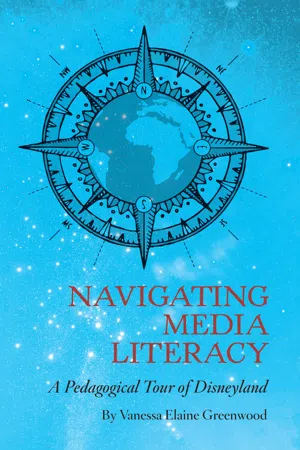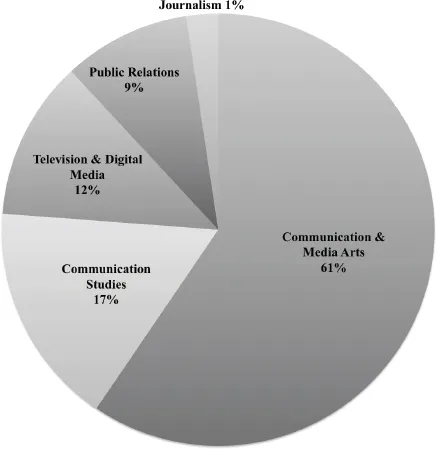![]()
CHAPTER ONE
Mapping Student Perspectives
I BEGIN WITH the fundamental principle that educators teach students, not curriculum. This necessitates knowing as much about students as possible at the beginning of the semester. This chapter presents student self-reported data and autobiographical writing samples that together provide foundational information about their individual experiences, knowledge, attitudes, and values. These qualitative data provide fertile ground in which media literacy questions can take root. Figure 1.1 shows that the majority of students enrolled in this course were communication and media arts (CMMA)–degree majors.
Figure 1.1
Breakdown of Students’ Major Program of Study
CMMA is the most popular major within School of Communication and Media (SCM) at Montclair State University in part because the program affords students a diverse set of learning experiences across three categories of elective course work: critical/analytical, creative/conceptual, and applied/production. These three areas provide a well-rounded learning experience for students. They can choose course work across the fields of communication studies, journalism, television and digital media, and film. Along these lines, I conceptualized the course to integrate students’ critical, creative, and applied knowledge and skills—all three competencies requisite to media literacy.
Course enrollment data indicate a predominantly female (79%) and White (62%) student population.1 Students were ranked as either juniors or seniors in their program of study and therefore familiar with the routine of university life. Most of them were commuter students living at home (within New Jersey) and working at least one part-time job. Some of the students worked multiple jobs and were the first in their family to pursue postsecondary education. All of them were full-time students enrolled in at least 12 credits of course work during the semester.
These students were born in the mid- to late 1990s, which qualifies them as Generation Z or “Gen Z.” This demographic has been exposed since birth (in varying degrees) to the internet, social networks, and the mobility associated with smart devices (Francis & Hoefel, 2018). Their academic programs of study within SCM required them to be continuously engaged in transmediated experiences. As such, their lived experiences straddle online and off-line environments both inside and outside their university studies.
ACCESS AND ANALYZE:
GENERATING MEANINGFUL DATA
Like most types of learning, media literacy education begins with activating prior knowledge. To learn more about these students, I crafted and administered an online survey questionnaire that asked the following:
•What is your chosen career path?
•Why did you choose to enroll in this course?
•What is one word that best describes you?
•If you won a million dollars, what would you do with it?
•How do you spend your time when you don’t have to do anything?
•Name one film that you have seen recently.
•What is your favorite childhood memory?
•What Disney character most closely resembles your character?
The data generated through the survey supplied me with preliminary information about student self-identity, media practices, and attitudes about and knowledge of Disney.2 Re-presenting some of these data back to students in aggregate form (to avoid singling out individuals) allowed me to situate their knowledge, experiences, and values within a wider social context and establish a foundation for other types of questions throughout the course.3
Media Literacy and Disney as Motivational Factors
It is not surprising that a majority of students reported taking the course solely because of their affection for Disney.4 More than 60% of students indicated Disney as the only reason they enrolled in the course. Illustrative responses include the following:
Of responses, 20% cited both media literacy and Disney as the reason for enrolling in the course:
The 20% of student responses that cited both media literacy and Disney were equally divided as to which one they privileged. Students who cited media literacy first may have simply crafted their response to mirror the course title rather than intentionally prioritizing interest in media literacy over Disney. It was difficult to discern. It is significant, however, that the first semester of this course occurred in the wake of the 2016 U.S. presidential election when the terminology fake news widely circulated. The idea of media literacy also gained traction during this time and most likely piqued student interest in the course. This is not to imply students have depth of understanding of what constitutes media literacy, however. A mere 10% of student responses (predominantly male) cited media literacy as the only reason for enrolling in the course:
Given that male students were the minority (21%) of course enrollment, it is also plausible they were inclined to downplay or even conceal their interest in Disney as something childish or feminine. I also acknowledge that as a female professor, my gender influences in different ways the attitudes, perceptions, and communication behaviors of both male and female students toward me, the course, and the subject of Disney (Basow, 1995; Miller & Chamberlin, 2000). That is not to say that the male students were uninterested in Disney. Female students may have also felt more comfortable disclosing to a female professor their authentic interest in Disney. The function of gender bias in the college classroom is complicated, and the research findings conflicting (Crombie et al., 2003). Nevertheless, I maintained a continual awareness of how student perceptions of gender and their communication about gender shape media literacy education in the context of Disney.
Student Self-Descriptors
Given the long-standing and significant correlation between student self-concept and academic achievement (Valentine et al., 2004), I wanted to know what students thought of themselves ...

